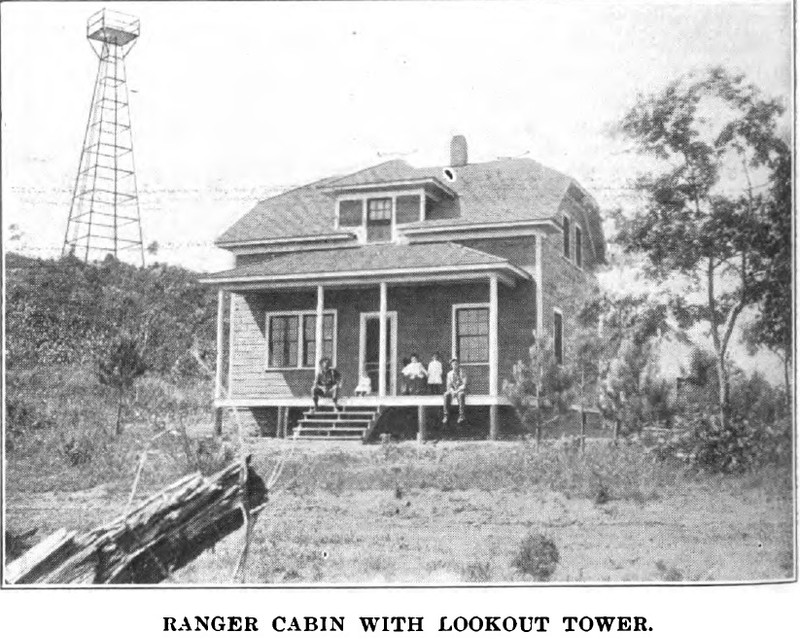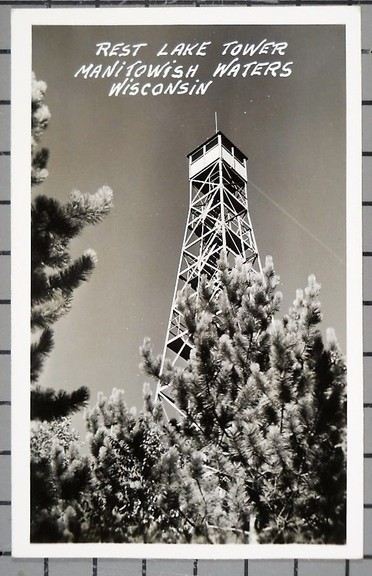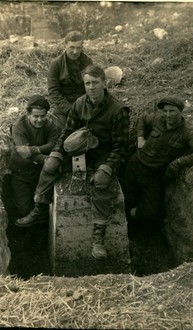Rest Lake Ranger Station
Introduction
Text-to-speech Audio
The Rest Lake Ranger Cabin and Fire Tower were one of the four original outposts created by the Wisconsin Department of Forestry in 1912 to stop the vicious forest fires that plagued the Northwoods.
Like spokes in a wheel extending from the Trout Lake Headquarters, new ranger stations could spot fires from 55-foot towers and report back to Trout Lake on new phone lines where Trout Lake rangers triangulated a fire’s location and coordinated fire responses. Rangers also utilized specialized firefighting tools and portable phones cached throughout the forest reserve to resupply and get fire updates from Trout Lake. Ranger stations also had bunk houses to maintain a corps of men for fire suppression, fire watch and building telephone lines, roads and fire lanes. Remote patrol cabins and auxiliary fire watch towers were later built to improve coverage and response time during fire season. Over time, new ranger facilities improved forestry employees’ response to critical needs within the forest reserve.
Images
1912 Rest Lake Ranger Station

Rest Lake Ranger Cabin and 55 foot tower 1912

View from Rest Lake Fire Tower

100 foot Rest Lake Tower

CCC men setting footings for the new Rest Lake tower built in 1934

Backstory and Context
Text-to-speech Audio
The Rest Lake Ranger Station and Fire Tower was part of state forester E. M. Griffith's plan to deliver effective fire control and forest management to the new forest reserve. Rest Lake was the western most forestry station that proved effective in building a fire prevention infrastructure and having teams of fire fighters ready to respond quickly. The ranger station was removed by the early 1920s, but the Rest Lake Fire Tower and a smaller ranger cabin remained until the 1950s.
In 1912, the original fire tower at Rest Lake was a 55-foot windmill tower with a makeshift cab placed on top. In the winter of 1933-1934, Civilian Conservation Corps enrollees from Camp Mercer dismantled the old tower and built a more modern 100-foot observation tower. By the early 1970s, the Rest Lake Tower was dismantled and moved to Harrison Hills, Wisconsin. The footings for the fire tower are still visible on the hill next to Angler's Fine Food and Spirits.
The Rest Lake Ranger Station was first operated by forest ranger Herman Kruger in 1912. Kruger and his family live in the ranger cabin, while additional forestry workers resided in the nearby bunk house. Shortly after 1915, the Rest Lake Ranger Station was downsized because automobiles and trucks could more efficiently transport fire fighters and forestry workers, allowing consolidation of forestry staff closer to the Trout Lake forestry headquarters. Improved roads and a new bridge between Spider and Manitowish lakes dramatically improved response times to fires. Still, ranger cabins remained on the property closer to the fire tower.
One of the unused forestry buildings was quickly repurposed as the Rest Lake School for children who lived nearby. The Rest Lake School operated in rented forestry buildings until the mid-1920s. By 1925, the Rest Lake forestry property along Highway 10 (Tower Road today) was subdivided to accommodate the Tower Inn and a satellite post office from Manitowish, Wisconsin. A few years later, the larger Tower Tea Room (tea was legal to serve during prohibition) was added to the subdivided land where the ranger cabin once stood.
Rangers continued to live on the forestry property near the fire tower until the 1950s. Unfortunately, the iconic Rest Lake fire tower was relocated in the early 1970s. Today, the town bike trail follows the curve of the hill that once helped elevate the fire tower above the tree line. Cyclists, hikers or folks having refreshments at Angler's can make the short climb up the hill to see the two geological marks and old footings for the CCC tower. The view of a red pine canopy is still pretty nice.
Sources
Biennial Report of the State Conservation Commission of Wisconsin For the Years 1915-1916. Manitowish Waters Historical Society PastPerfect Online. Manitowish Waters Historical Society. Accessed June 2, 2022. Madison Wisconsin: Cantwell Printing Company, State Printer, 1916. p.132. .http://ppolinks.com/mwhistory/1915-16%20Biennial%20Report%20State%20Con%20Comm%20of%20WI.pdf
Bokern, James. Wisconsin's First Forest Rangers. Manitowish Waters Historical Society PastPerfect Online. Manitowish Waters Historical Society . http://ppolinks.com/mwhistory/2020_2_1%20First%20Forest%20Rangers.pdf
The University of Wisconsin Department of Agriculture. "The Forest Ranger Course 1914". Manitowish Waters Historical Society PastPerfect Online. Manitowish Waters Historical Society . Accessed June 2, 2022.https://mwhistory.pastperfectonline.com/library/94DF5FB0-8170-490B-BB01-500605643017
Report of the State Forester of Wisconsin 1911 to 1912. http://ppolinks.com/mwhistory/1911-12%20Report_of_the_State_Forester.pdf
Manitowish Waters Historical Society
MWHS Archives
MWHS Archives
MWHS archives
